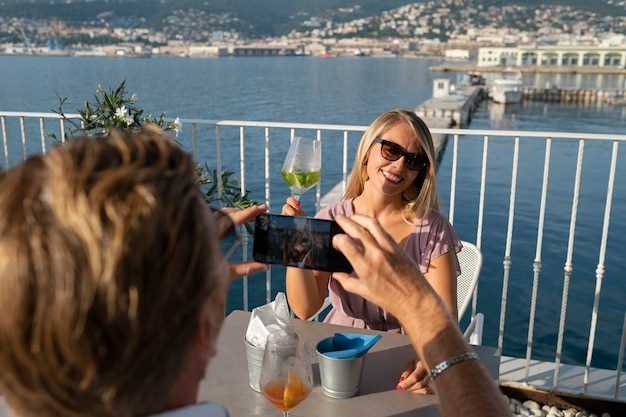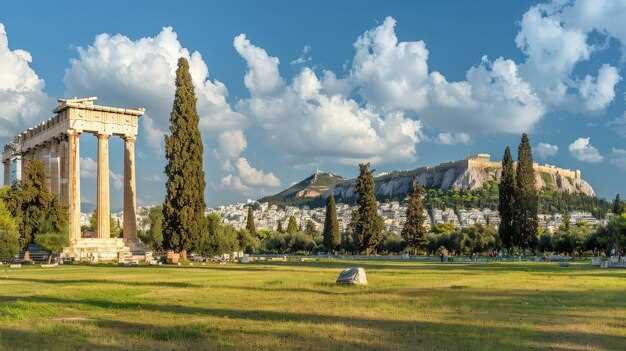
Head to Mount Lycabettus at sunrise for a fantastic, breathtaking shot that anchors your Athens feed. The peak is located just north of central Athens and offers a 360-degree view that reveals the city’s long silhouettes and the atmosphere turning warm as the day begins.
From there, you can find easy routes to the ten spots around the historic center, including Plaka, Anafiotika, and Monastiraki, where the streets surround you with old stones and such intimate textures that photograph well at a regular pace. If you plan well, you will come away with a mood board of light and color that spans daytime and dusk.
Walk along ermou Street toward Monastiraki; the avenue is lined with shops, balconies, and constant movement that create a dynamic design for your feed. The atmosphere shifts with the time of day, offering you opportunities for both wide-angle and close-up shots.
For a breathtaking Acropolis backdrop, head to Areopagus or Filopappou Hill; both spots are surrounded by olive groves and city roofs, offering breathtaking backdrops that pair with sunset light. Plan a route that comes back through the Agora area for a fantastic contrast of ancient and modern textures.
In the late afternoon, consider a coastal option at Flisvos Marina, where the sea reflection adds a soft glow to your frame and the long jetty lines help streamline perspective. This complements interior courtyards in Psyrri and the graffiti walls in Gazi, giving you variety without a long commute.
For those arriving from abroad, check evisa requirements before you travel, and look for boutique stays near Ermou’s hub so you feel at home when you finish a shot. A practical idea is to map a loop that starts at Lycabettus, sweeps through the old town, and ends at the marina. That route will help you capture the seven recurring motifs that define Athens’ photo identity: light, texture, height, color, movement, water, and greenery.
Remember that planning and pace will help you create a cohesive story that your audience will love, thats the tone you aim for.
Acropolis Hill & Parthenon: best dawn angles

Begin at Areopagus 40–50 minutes before sunrise to catch the first light kissing the Parthenon; stay low and let the east glow define the columns while Athens wakes, definitely a moment you won’t forget.
Descend to the Mnisikleous base for a close-up; frame the Parthenon with the stair rails and the Theater of Dionysus in the foreground; this fabulous combo yields a crisp snap.
From Areopagus, tilt slightly to the south for a long, most dramatic view that includes the Parthenon’s west end and the Acropolis hill silhouette against the pink dawn; particularly rewarding is the subtle color shift within the marble.
Even with city traffic, early light remains stable; planning to visit both vantage points within the urban frame; from areopagus to the base, there are many stations along the route to pause for a breath and adjust.
Here, a simple order: start at Areopagus, move to Mnisikleous, then return to the base, and wrap with a final snap toward the Parthenon as the city comes alive; ioana, though, thissio tip: patience yields the most natural light. This approach can work well here.
Temple of Olympian Zeus & Temple of Hephaestus: rooftop views
Head to a rooftop terrace in central Athens before sunset to capture both the Temple of Olympian Zeus and the Temple of Hephaestus in a single frame. Choose a level above the streets where the city opens toward the hill and the temple silhouettes stand against the sky. At a well-known hotel or rooftop bar, you can purchase a drink and linger; costs for access and beverages vary, but a glass of wine or coffee usually stays under 15 EUR. If you want fewer gatherings, aim for late afternoon on weekdays when crowds gather elsewhere. Take your camera, your own machine, and go–this true moment reveals the beauty of a capital steeped in culture.
From that height you get a visual of the two sites as anchors of a cultural setting and a trace of unknown corners of ancient life. The Temple of Olympian Zeus dates back to the 6th century BCE and its ruined colonnade forms a grand hall of stone that opens to the skyline; the Hephaestus temple, tucked among the Agora’s gardens, feels like a village museum where time slows. From a rooftop vantage, the line of columns becomes a machine-inspired rhythm against the modern city. A short flight of steps leads to terraces that open views over the capital and its marble relics; the level of access often depends on the building you choose.
Best rooftop viewpoints and how to access
Seek out terraces at central Athens hotels and rooftop bars around Syntagma, Monastiraki, and the Agora–these spaces open for visitors with a purchase of a drink or a small table reservation. Arrive at golden hour to catch the true colors of the columns and the city lights coming on. If you would rather a cheaper option, some public terraces offer free access after a light purchase, but check hours ahead as openings shift with the season. The view includes the hill, gardens, and the arching colonnades of the Olympian Zeus; you may even spot a quiet square where locals gather for conversations after a long day in the capital.
Tips for capturing the scene
Take advantage of a stable stance and a wider lens to include both temples in the frame. Use a moderate ISO and a tripod if allowed; a small tripod on a stable rail can keep the image sharp when the light fades. Create compositions that lead the eye toward the tall columns, then head toward the Hephaestus temple for context, aiming for a balance between the ancient ruins and the modern skyline. If you shoot in crowds, wait for gaps in the gatherings to avoid clutter and to keep the architecture crisp. Remember to head yourself into the frame of the shot by stepping back from the edge and scanning the gardens below for color and texture, which adds depth to the shot. Many angles exist on this hill and the adjacent gardens, so experiment and capture the beauty that remains true to the site’s history.
Lycabettus Hill & Areopagus Rock: panoramic cityscapes
Go to Lycabettus Hill at sunrise for panoramic cityscapes youre going to remember. From the central terrace you capture a 360-degree sweep: the Acropolis, the panathenaic stadium, and the white neighborhoods spilling toward the sea. This spot is known among travelers as a popular destination for photographing, and if youve planned a morning shoot you can expect the city waking up with soft light and long shadows, with locals and lovers claiming the best angles early.
Areopagus Rock offers a different scenic angle: you stand above the Agora’s ancient stones, with the Acropolis rising behind and the modern city unfurling toward the sea. From this rock you get a compact, dramatic panorama where signs along the path guide your steps, and the light grows colorful as sunset approaches.
Gear and planning: carry a versatile lens for both wide views and tight details; a nikon camera fits well for travel shoots. For Areopagus and Lycabettus you can mix wide shots with close textures near herodes Atticus Theatre, which adds a cultural layer to every frame. Start with a drink at nearby cafés, then head up; the metro helps you reach central stations, and next you can walk or take a short ride to the summit. This approach keeps things smooth and helps you create colorful, layered shots.
What to shoot
Look for colorful façades, terraces, and silhouettes of lovers framed against a skyline. From Lycabettus you can capture the dawn glow over the central city; from Areopagus you can frame the ancient stones with modern streets, and include the panathenaic stadium and the distant skyline. The signs and lamps add a graphic layer to your composition. Photographing these spots lets you create a story of cultural contrasts that travel lovers will enjoy.
Planning your visit

Spots to keep in mind: start early from central Athens; carry a Nikon body or any camera you know; planning your route with the metro plus a short walk saves time; youve got everything to build a great sequence, from sweeping cityscapes to intimate corners near Herodes Atticus Theatre and the ancient lanes around Monastiraki.
| Spot | Best Time | Access |
|---|---|---|
| Lycabettus Hill – Central Terrace | Sunrise or blue hour | Metro to Syntagma or Kolonaki; optional funicular from Kolonaki; 10–15 min walk to the summit |
| Areopagus Rock | Sunset | Short walk from Monastiraki; moderate uphill climb; follow signs along the path |
| Herodes Atticus Theatre vicinity | Evening glow | Access from the Plaka side of the Acropolis; pair with Areopagus shots for a layered sequence |
Anafiotika streets & Plaka lanes: narrow alley composition
Use a wide-angle lens to capture the narrow alley composition of Anafiotika and Plaka. The tall white walls, exposed stone, and stair-stepped levels create an impressive frame that instagrammers love to share on their blog.
Aim for frames within frames: arches, doorways, and window alcoves pull the eye inward, while a touch of human presence–a passerby, a cafe sign, or a plant–adds life. When you capture, keep the foreground sharp and let the distant walls or sky soften under soft light. Should you shoot during bright sun, angle the shot to minimize harsh shadows and keep details visible.
- Frame within a frame: archways, door frames, stair landings that guide the viewer toward a pastel doorway.
- Highlight texture: plaster, chipped paint, blue shutters, flowering pots, and tiled steps.
- Use color accents to contrast with white walls: cobalt doors, green balconies, or bright awnings.
google imagery and blog notes can help you plan the route. Plan a loop that begins in Anafiotika, threads down to Plaka lanes near zappeion, then returns along a quiet stair path. Admission here is simple: wander, observe, and shoot when a moment feels open and real. You need to pace your steps so you stay near the wall for better perspective.
Equipment and technique: monitor perspective to avoid distortion; a touch of zoom can compress the scene for drama, while the wide-angle preserves the urban texture. For night or blue-hour shots, a lightweight tripod helps stabilize longer exposures in the narrow passages where light pools from street lamps and cafe signs.
Lighting and timing: the early hours or late afternoon provide gentle shadows that sculpt the alleys and reveal textures. If you shoot candid scenes, stay near a cafe and let locals interact with the frame for a natural vibe that resonates with instagrammers and readers of your blog.
Bottom line: to deepen your eye for urban places, a short session at an academy or a local photography workshop can sharpen your angles and help you explore vantage points without rushing. These lanes invite you to get close, capture the moment, and leave with a set of images you enjoy revisiting in your blog or on social feeds.
Little Kook & Monastiraki rooftops: whimsical interiors and skyline backdrops
Begin your Athens photo-quest with Little Kook in the Psirri district, then walk down to Monastiraki rooftops for a skyline backdrop that pairs whimsy with city grit. The closest terrace sits just around 300–400 meters from the square, and you’ll capture the acropolis above as you weave between cafés and market stalls. The route is short enough to fit a next stop into the same afternoon, leaving you plenty of time for both indoors and outdoors shots.
Inside Little Kook, expect a full fairy-tale interior that has evolved over many years. The style blends vintage carnival charm with fantastical murals and a ceremony atmosphere, a stage-like setting perfect for creative portraits. Here, vegan options appear on the menu, keeping the experience inclusive for travelers with different needs. If you plan ahead, ask for a corner seat that faces the next rooftop moment and the light that pours in from the windows. The decor nods to emperors and legends, adding a playful depth to every shot. A tiny throne nods to the emperor of fairy-tales.
From Little Kook you descend to Monastiraki rooftops, where popular terraces offer equally dramatic skyline backdrops. Look for rooftops that sit just above the square, with views over the roofs toward the acropolis in the distance and the buzz around exarcheia to the north. Use maps to compare the closest options and time your visit for the hour before sunset, when the light bathes the stones in warm tones. Here, you can choose a corner seat near the edge for the best view above the city. Some venues add a small ticket for terrace access, while others include it with a drink order or reservation.
Here’s a practical plan: start at Little Kook, then chase rooftop views from Monastiraki between late afternoon and sunset, for golden hour shots. Travel between sites by foot in under 15 minutes, or use a quick ride if the weather shifts. The area around Monastiraki is known for many cafés and vegan-friendly venues, so you can align a light meal with your photo stops. If you want to join a workshop or a micro-tour, tickets are often available for timed slots. For a smoother experience, stay flexible with your timing, since probably the best light appears just before dusk. Maps help you plan meters of walking and time between stops.
